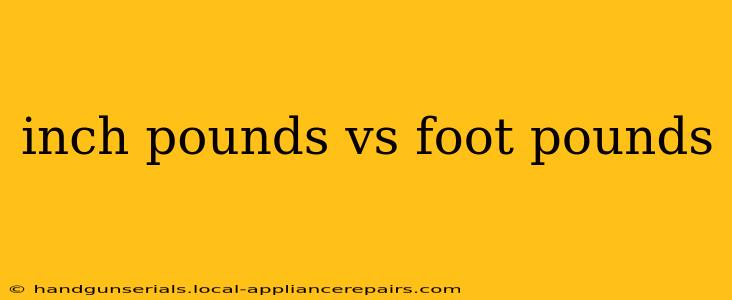Torque, the rotational force that causes an object to rotate around an axis, is crucial in various fields, from engineering and mechanics to everyday tasks involving tightening screws or nuts. Understanding the units used to measure torque, specifically inch-pounds (in-lb) and foot-pounds (ft-lb), is essential for accurate calculations and avoiding potential damage. This article will clarify the difference between inch-pounds and foot-pounds, highlighting their applications and conversion methods.
What are Inch-pounds (in-lb)?
Inch-pounds represent a smaller unit of torque. It measures the force applied at a distance of one inch from the rotational axis. Imagine you're tightening a bolt with a wrench. If you apply a force of one pound at a distance of one inch from the bolt's center, you're applying one inch-pound of torque. This unit is commonly used for smaller applications, such as:
- Small engines: Torque specifications for model engines, small power tools, and similar equipment often use in-lb.
- Electronics: Many electronic devices and components utilize in-lb for their torque requirements.
- Fine mechanics: Precise applications in watchmaking, jewelry making, and other areas of fine mechanics frequently employ in-lb.
What are Foot-pounds (ft-lb)?
Foot-pounds represent a larger unit of torque. It measures the force applied at a distance of one foot from the rotational axis. This unit is more frequently encountered in applications involving greater rotational force, such as:
- Automotive: Torque specifications for car engines, wheel nuts, and other automotive components are typically expressed in ft-lb.
- Heavy machinery: Large industrial equipment and machinery utilize ft-lb to indicate the significant torque required for their operation.
- Construction: Construction tools and equipment often use ft-lb to describe the torque capabilities of their components.
Converting between Inch-pounds and Foot-pounds
Converting between these units is straightforward. Since there are 12 inches in a foot, the conversion factor is simply 12:
- To convert inch-pounds to foot-pounds: Divide the inch-pound value by 12. For example, 144 in-lb is equal to 144 in-lb / 12 in/ft = 12 ft-lb.
- To convert foot-pounds to inch-pounds: Multiply the foot-pound value by 12. For example, 10 ft-lb is equal to 10 ft-lb * 12 in/ft = 120 in-lb.
Choosing the Right Unit
Selecting the appropriate unit depends entirely on the application. Using the wrong unit can lead to significant errors, potentially causing damage to equipment or leading to inaccurate results. Always refer to the manufacturer's specifications to ensure you use the correct torque value and unit for the task.
Importance of Accurate Torque Measurement
Precise torque application is crucial for various reasons. Applying too little torque can lead to loose connections, while applying too much can result in stripped threads or broken parts. Using the correct units and ensuring accurate measurement is paramount in many industries to ensure safety, efficiency, and product longevity.
Conclusion
Understanding the difference between inch-pounds and foot-pounds is vital for anyone working with rotational forces. While the conversion is simple, using the correct unit for the appropriate application is critical to prevent errors and ensure optimal performance and safety. Always consult the relevant documentation and specifications for the specific task to avoid potential issues.

